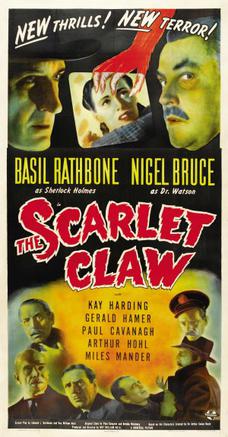Plot
Sherlock Holmes and Dr. Watson are in Canada attending a conference on the occult, when Lord Penrose receives a message that his wife Lady Penrose has been murdered in the small village of La Morte Rouge. [3] Holmes and Watson are about to return home when Holmes receives a telegram from Lady Penrose, sent before her death, asking for help as she fears for her life. Holmes decides to investigate her death.
Holmes and Watson arrive at the village and discover that the inhabitants are all convinced that the murder is the work of the legendary monster of La Morte Rouge, which roams the marshes around the village. The "monster" is even later seen by Dr. Watson, who describes it as "the mostly ghastly apparition... like a roaring furnace spitting fire in all directions".
Holmes, however, is skeptical, and recognizes Lady Penrose as Lillian Gentry, [4] a former actress, who was involved in a famous murder case several years before when actor Alistair Ramson killed another actor in a jealous rage over her. Ramson was believed to have been killed in a prison escape two years before, but now Holmes believes that Ramson - a master of disguise - is living in the village, having created a new identity, perhaps several, for himself.
Holmes then turns his attention to Judge Brisson, another inhabitant of the village with a connection to the case, as he passed sentence on Ramson. Despite Holmes' warnings, Brisson is murdered. Holmes tracks Ramson down to his hideout and discovers there is a third person that Ramson is preparing to kill. While Ramson is holding Holmes at gunpoint, Watson blunders in and Ramson escapes, albeit before Holmes can learn who Ramson's final target is.
Holmes learns that the third victim is to be Journet, the local inn-keeper, formerly a prison guard. However Journet has gone into hiding. Ramson then kills Marie, Journet's daughter, for not revealing her father's hideout. Holmes finds Journet and convinces him to spring a trap for the murderer.
Holmes and Watson announce that they are returning to Britain, and Journet comes out of hiding and lets it be known that he will be going to a church across the marsh to offer a prayer for Marie. Ramson attacks Journet out in the marsh, only to find that it is Holmes in disguise. The two men struggle, but Ramson escapes only to be killed by Journet with the murderer's own weapon, a five-pronged garden weeder. [5]
Production
The film is not credited as an adaptation of any of Sir Arthur Conan Doyle's Holmes tales, but it bears a significant resemblance to his 1902 novel The Hound of the Baskervilles . Alan Barnes, in his book Sherlock Holmes On Screen, describes The Scarlet Claw as "owing much" to Hound, listing their similarities: "a remote marshland setting; a painted-phosphorescent but thought-supernatural terror, an escaped convict on the loose, a cold killer ingratiating himself with everyone in the vicinity; a subplot involving cast-off clothing; plus, of course, Holmes' method of unmasking the murderer, making to return home but actually remaining behind to catch the villain red-handed (or, indeed, scarlet-clawed)." [6]
Early in the film, Watson's character directly refers to The Hound of the Baskervilles.
At the very end of the film, Holmes quotes from Winston Churchill, after which Watson asks, "Churchill say that?" Holmes replies "Yes, Churchill." The music swells and Rathbone's voice drops, but he continues to speak several more words which are not heard, but lip movement indicates that he says, "God bless him."
This page is based on this
Wikipedia article Text is available under the
CC BY-SA 4.0 license; additional terms may apply.
Images, videos and audio are available under their respective licenses.
